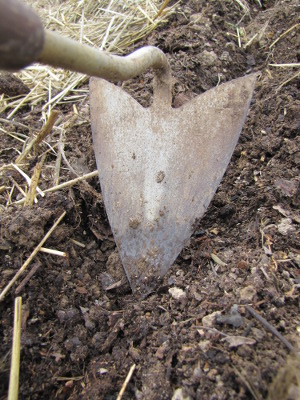
Top-dressing compost in a no-till system
 I'm
still making basic beginner mistakes as I figure out the best ways to
work with a no-till system. Since I
don't want to disturb the soil, I've been tossing my soil
amendments on top of the ground and counting on rain and worms to bring
the nutrients down into the root zone. But my first lettuce bed
proved that this method isn't going to work during a droughty
February. Every few days, I'd peek under my quick
hoop and look for
sprouts, and nothing ever seemed to happen. Finally, I realized
that the composted manure had dried out on top, so the tiny lettuce
seeds I'd sprinkled on the surface weren't going to sprout. After
two bouts of heavy hand-watering, lettuce roots finally appeared.
I'm
still making basic beginner mistakes as I figure out the best ways to
work with a no-till system. Since I
don't want to disturb the soil, I've been tossing my soil
amendments on top of the ground and counting on rain and worms to bring
the nutrients down into the root zone. But my first lettuce bed
proved that this method isn't going to work during a droughty
February. Every few days, I'd peek under my quick
hoop and look for
sprouts, and nothing ever seemed to happen. Finally, I realized
that the composted manure had dried out on top, so the tiny lettuce
seeds I'd sprinkled on the surface weren't going to sprout. After
two bouts of heavy hand-watering, lettuce roots finally appeared.
To prevent this problem
in other beds I plan to direct-seed this spring, I'm gently working the
manure into the top inch of the soil. This triangular hoe that
Mark's mom gave us over the summer turns out to be perfect for surface
incorporation without disturbing the lower soil profiles.
Most of the garden,
though, can simply be topdressed, mulched, and then ignored until it's
time to plant. Transplanted broccoli seedlings and potato tubers
won't have any trouble growing in a layer of manure over soil, and I
suspect our healthy earthworm population will work the manure into the
soil before it's time to plant summer crops.
Want more in-depth information? Browse through our books.
Or explore more posts by date or by subject.
About us: Anna Hess and Mark Hamilton spent over a decade living self-sufficiently in the mountains of Virginia before moving north to start over from scratch in the foothills of Ohio. They've experimented with permaculture, no-till gardening, trailersteading, home-based microbusinesses and much more, writing about their adventures in both blogs and books.
Want to be notified when new comments are posted on this page? Click on the RSS button after you add a comment to subscribe to the comment feed, or simply check the box beside "email replies to me" while writing your comment.
